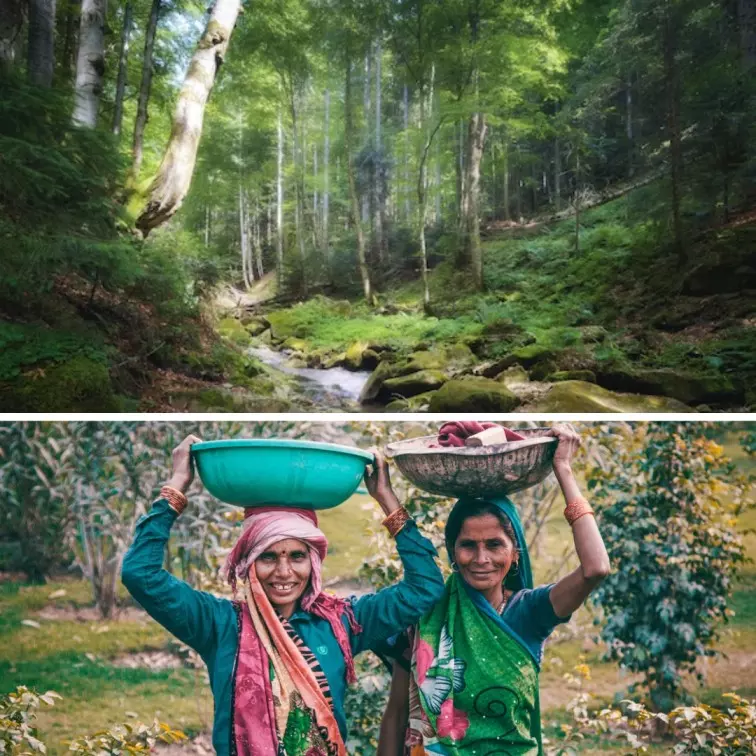Meet The Women Of Anchala Village Who Revived & Rejuvenated A Forest Over 30 Years
Odisha, 6 Dec 2022 11:54 AM GMT
Editor : Ankita Singh |
A literature lover who likes delving deeper into a wide range of societal issues and expresses her opinions about the same. Keeps looking for best-read recommendations while enjoying her coffee and tea.
Creatives : Jayali Wavhal
She writes about gender issues, human interest, and environment.
The women of Anchala took several steps to revive the natural beauty of the forest. Besides adopting communal cooking to reduce their dependency on firewood, they practised eco-friendly and organic farming for a sustainable future.
In early 1990, residents of Anchala village in Odisha's Koraput district were concerned about the surrounding natural environment. The village had no green trees in sight and the only stream flowing through Mali hill had now narrowed to a trickle. The villagers decided it was time to take matters into their own hands and resuscitate the natural life in the village.
Today, after 30 years of consistently practising conservation, the women of Anchala have revived and rejuvenated the 250-acre mountainous forest area which now comprises dark green lush trees with a lively stream flowing through it. The water from the stream is not only used in the farms and fields but also for household chores.
The women of Anchala took several steps to revive the natural beauty of the forest. Besides adopting communal cooking so that they could reduce their dependency on firewood, they practised eco-friendly and organic farming.
Designated Families To Guard Forest
When the movement started, the women prioritised the prevention of deforestation. They appointed a guard to keep vigil, and a family was designated to guard the forest from dusk to dawn so that no trees in the forest were being cut down. The designated family would get 10 kg of finger millet or ragi – which was collected in small amounts from each household – in exchange for their service.
Speaking about their movement, Shuparna, who was 15 and newly married at the time, said, "We imposed a strict fine of Rs 500 on anyone cutting wood and created an environment where the person was reprimanded in public for cutting wood. We made them feel guilty for their actions. After a point, it started working and more and more people started joining our movement", reports The Hindu.
From Communal Cooking To Planting Trees
Since the village had no access to LPG cylinders at the time, they would rely on using wood for cooking. With every household using a certain amount of wood, conservation of the forest seemed a far-fetched goal. So, the villagers changed their cooking habits.
"We made do with less wood and cooked for three families together so as to reduce the usage of wood and coal," 65-year-old Lali said.
Besides adopting communal cooking, the women also started planting trees. Such as tamarind, sandalwood, and neem. Such were the efforts and hard work invested into planting the trees, that when the first tree grew, the villagers celebrated it like a festival.
As the barren land started transforming into a lush forest region, wild animals started living in the jungle. Wild boars, barking deer and several other animals became a common sight,
Sustainable And Organic Farming
Following the consistent efforts at conserving and rejuvenating the forest, the stream too started flowing with a gush. Soon, the water from the stream was used for household chores and farming, and it sufficed for everyone in the village.
The women planted peas, ginger, and cabbage among other things in their fields and used the water from the stream for irrigation. Since they found themselves to be ecologically reliant on a steady supply of water, they also decided to switch to sustainable farming practices.
Not only did the women use chemical-free pesticide which was made from a mixture of cow manure, jaggery and flour, but they also started using organic compost which was made from a mixture of neem, ash and chicken waste.
The NGO Foundation for Ecological Support (FES) educated and trained the women on these techniques and also on seed treatment and growing intercrops. "The main aim of non-pesticide management is to replace external chemical products with farmers' knowledge, skills, and local resources. We also teach them how to spot the changes and stem the damage at a stage when pests can easily be controlled," said Murali Krishna from FES.
Gradually and eventually, the steady efforts of the women to conserve and rejuvenate the forest yielded results. Today, the heavy forest region has made Anchala a self-reliant village that is an example for several others.
Also Read: Tired Of Waiting For Administratives, These Tribal Villagers Build A Road For Themselves
 All section
All section















